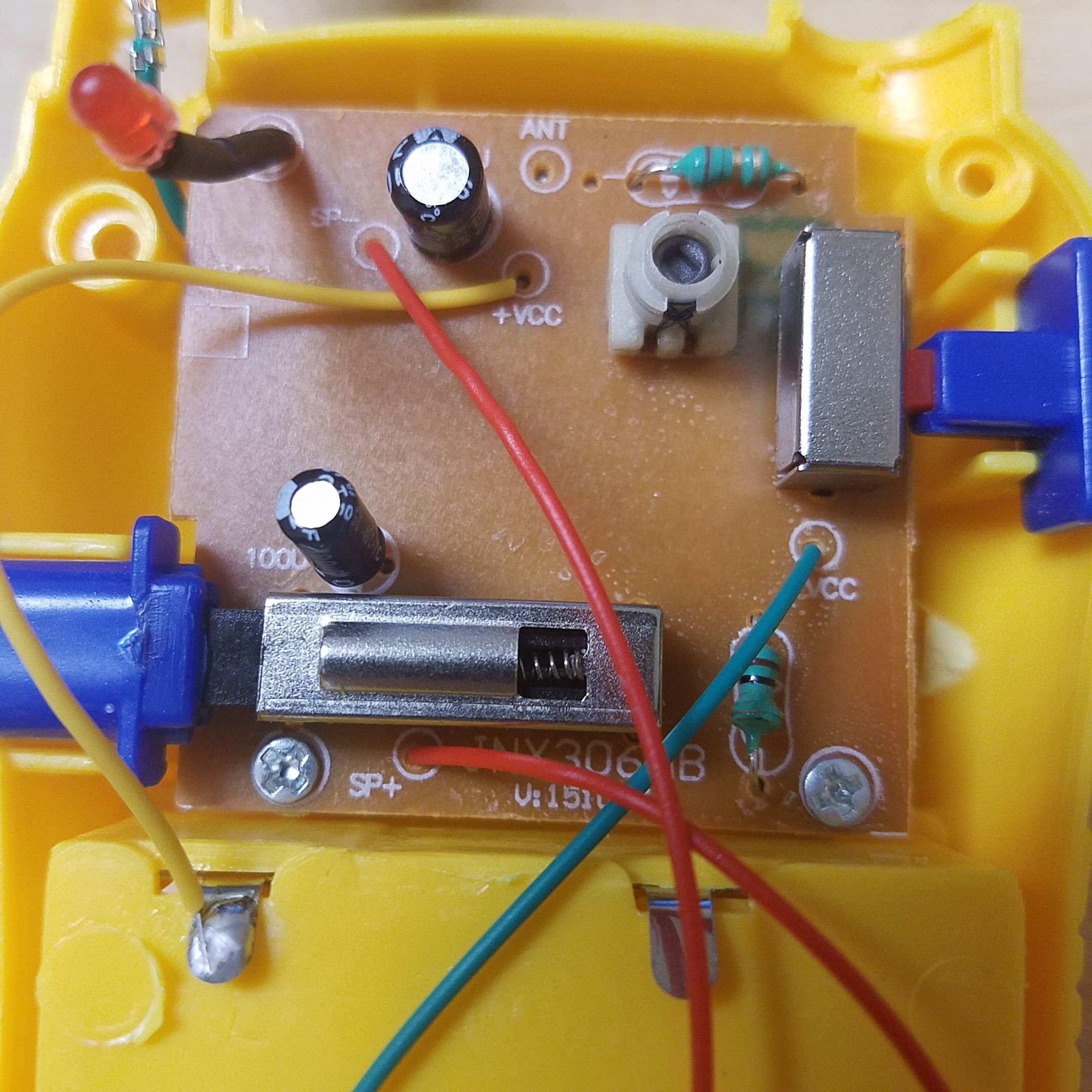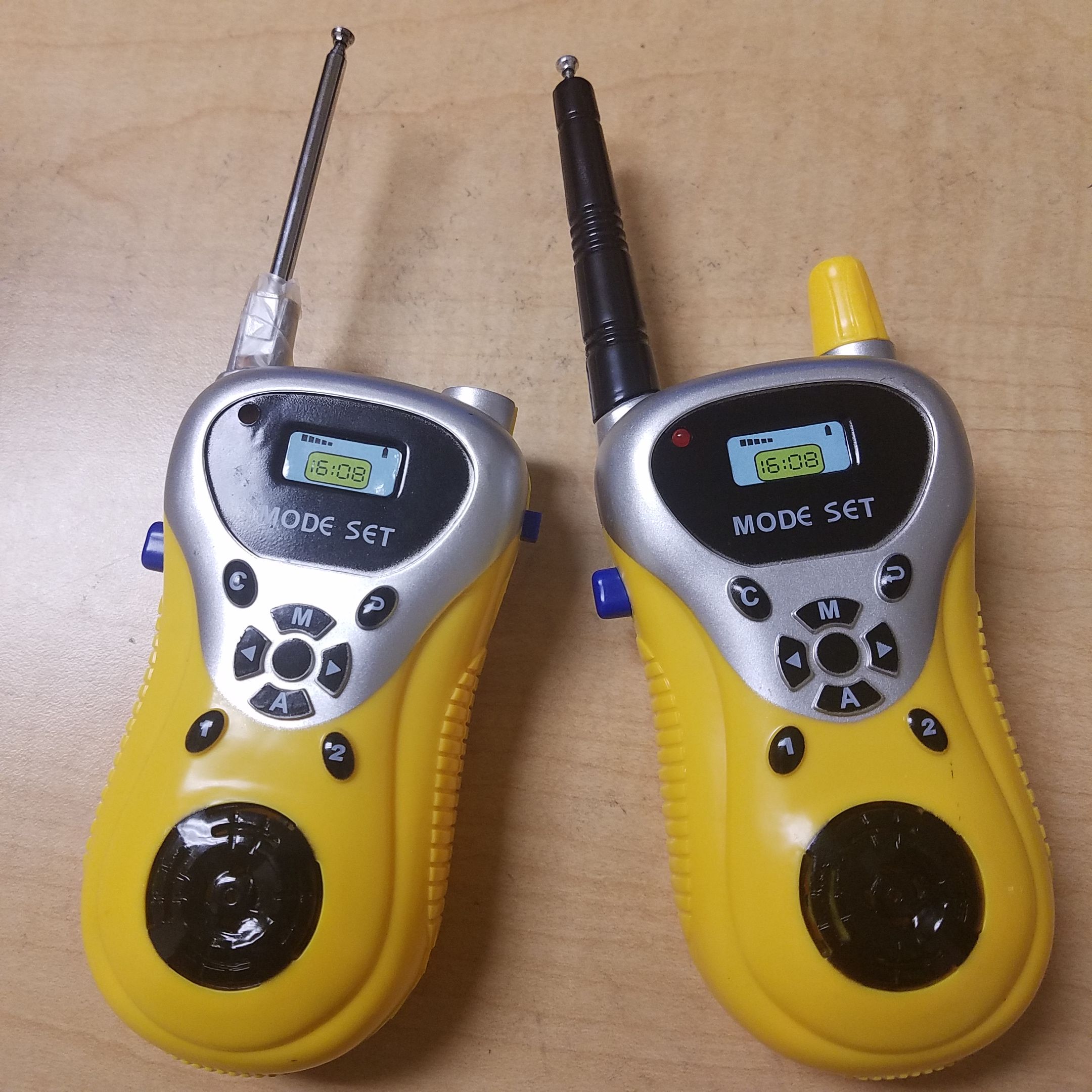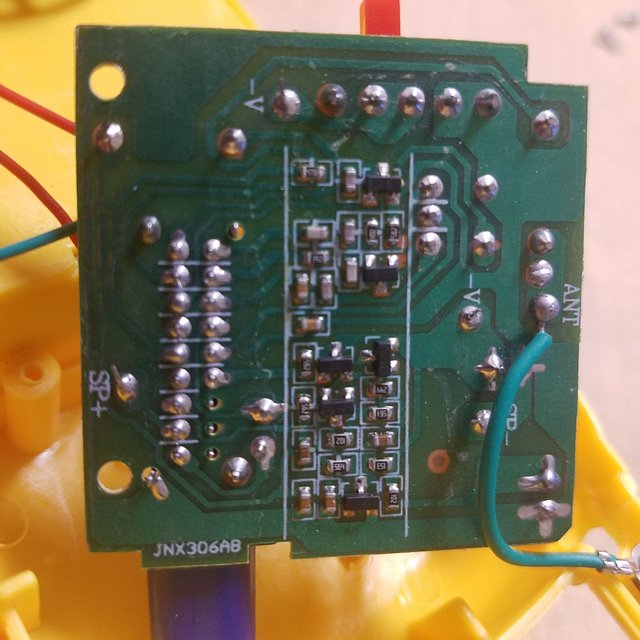Teardown/Explanation of the worst walkie-talkie radios in existence
Ever wonder what's inside a decent, high-quality walkie-talkie? Well, I can't really help you with that today, but I can show you what's inside an absolutely terrible walkie-talkie radio. I ordered these abominations on Ebay a few weeks ago, receiving two walkie-talkies earlier this week for the total price of about $6 USD with shipping included. Normally when I get electronics on Ebay, they either exceed my expectations or were so cheap that how they work is irrelevant.
This time, against my better judgement, I decided to pick up the cheapest UHF (~400 MHz) radios I could find on Ebay to see if they actually work, and perhaps try to make a directional antenna for them. These happened to be bright yellow walkie-talkies, and wow, are they terrible.
So, without further introduction, let's talk about what's inside a cheap walkie-talkie, how they work, and why they absolutely suck.
Teardown and Overview of the World's Worst Walkie-Talkies
Externals
The package contained two identical walkie-talkies, so that one can talk to the other.
Now let's get the very few good things about these devices out of the way: They do technically work. The devices have somewhat decent extendable metal antennas and can transmit audio between themselves across a small room in my apartment. So at the very least, they do function as walkie-talkies ... sort of. It's not really as good as it seems, though, as I'll get to.
Understandably I don't think I was the target audience for these devices. The radios appear as oversized, yellow toys made of cheap glossy plastic. The front panel is really something to behold:
As you can tell, serious thought and passion was put into the design of this front panel. A faux LCD displays a beautifully printed time and battery level. As they say, it's 5 o'clock 4:08 somewhere, and the manufacturer of these radios clearly took this to heart.
Essentially everything on this radio is fake. I don't know why they didn't just ... not add fake buttons, as it would look better and maybe require less effort on their part. The LCD is a sticker, all of the front buttons are just painted bumps in the plastic. Even the volume knob is fake - yes, the manufacturer was too cheap even to put a cheap potentiometer in as a volume knob.
The only real things on the front panel are a red ON LED, an on/off switch, and a transmit button. The antenna visible at the top also extends out to about ~25 cm in length.
The back of the radio has a hatch to put 3 AA batteries in to power it.
Opening it up
Five screws later, and we're inside. Thankfully whoever designed this didn't intentionally make it hard to take it apart, which is somewhat refreshing. Inside, we can see the circuit board:

It's amazing how much they spent on that large, spring-loaded push button for the transmitter when everything else is so bad...
Inside, the front face of the PCB is visible. It's very ... sparse. Other radio innards I've seen have far more than this going on.
Visible are the on/off switch, the transmit button, a red indicator LED, three inductors, and two electrolytic capacitors. At the bottom is the dedicated speaker, which of course plays audio received from the antenna radio waves. Interestingly, they have given it a second use as a microphone. When transmitting, the speaker's output is cut off, and it generates a signal when incoming sound waves vibrate the outer membrane of the speaker. This lets the speaker act as a crude microphone, sending converted audio signals to the transmitter electronics to be broadcast out of the antenna. When the radio isn't transmitting, the speaker lets you hear static (or voices, but mostly static) picked up by the antenna from the air.

At least they labelled their components?
But so far, other than the fake front panel buttons and screen, we haven't really gotten to the bad part yet. Let's see the back side of the PCB before I get to that.
Nothing wrong here, really. It's not that many components compared to other transmitters I've seen, but it clearly transmits so that's not a problem. The six black devices are transistors, essentially electrical switches/amplifiers. The small brown rectangular devices are surface-mount capacitors, and the black rectangles with numbers on them are surface-mount resistors. All of these work together with the three inductors out front to form a radio-frequency oscillator. This oscillating current is fed into the antenna to radiate electromagnetic radiation into the air, allowing the other walkie-talkie to pick up a signal and listen in.
The green wire is the antenna, and leads to the large collapsible antenna, which is screwed to the wire at the top of the plastic shell.
Frequency Problems
I have a very low opinion of these radios, and this part is a big reason why. The walkie-talkies were advertised on Ebay as being UHF radios - that is, they were said to transmit on the 409-410 MHz range with adjustable channels. Well, adjustable channels definitely isn't here as shown by the mass of fake buttons and lack of any way to change the frequency, but I still assumed that it was transmitting somewhere around 410 MHz. If it was, it would let me use these radios with my more powerful UHF/VHF handheld transmitter.
After five minutes of cycling through a bunch of frequencies between 409 and 410 MHz I found nothing. Scanning also turned up nothing. Eventually I tried using an oscilloscope on campus. Hooking the oscilloscope up to the antenna revealed that the true frequency was just below 50 MHz. This is way into the VHF band, outside the range of my other radio. It's also not even technically legal in the US, lying outside the amateur band (not that anyone's going to care as these radios have almost no range).
What's hilarious about this is that the advertised frequency was off by quite literally a factor of 10. In fact, it turned out that every single item in the Ebay description for this product was wrong/a lie, except the physical dimensions of the shell. Stuff like "battery indicator", "LCD", "410 MHz transmit", "takes AAA batteries" (yes they even lied about the battery type, which I found weird) were all blatant lies of advertising. I'm not too concerned, since I didn't actually need most of these features, but the horribly wrong frequency was irritating.
This frequency also makes them somewhat bad in general. Electromagnetic waves have a wavelength determined by their frequency and the speed of light. For 410 MHz, this wavelength is about 70 centimeters. Most handheld antennas are monopole antennas, which work well when they are made to be about 1/4 of the wavelength of the desired frequency wave (although there are other options). For 400 MHz, this is quite doable. For 50 MHz, this becomes a problem. 1/4 Wavelength for 50 MHz is about 1.5 meters, since the wavelength is 6 meters. Unless I am incorrect, this makes the measly ~30 cm antennas on these walkie-talkies inadequate for the task of efficiently radiating 50 MHz radiation.
Since radio receivers work by analyzing an alternating current produced on the antenna by incoming radio waves, the inefficient antenna will also hurt the ability of the receiver radio to receive signals alongside the ability of the transmitter to transmit. This probably (unless these guys know something about antennas I don't, which is very possible) makes the entire setup very, very inefficient and adds to the bad range of the walkie-talkies.
For some perspective, AM radio stations lie around ~ 1 MHz and FM radio stations lie around ~100 MHz. I'm not sure if these walkie-talkies use FM or AM since I was unable to pick them up on my other radio, but if I had to guess I'd say they used FM since most walkie-talkies do.
I'm sure this low frequency was done for cost reasons - higher frequency oscillators are usually harder to make.
Range
This poor frequency choice (that they insisted on lying about for some reason even though most buyers wouldn't care), resulting in the antenna being terrible, probably contributes to these devices' pitiful range. The walkie-talkies lost each other after a maximum indoor distance of 10 meters, making them essentially useless indoors. I haven't tried them outside yet. The Ebay listing claimed something like 800 meters outside, but I am sure this is a total lie like the rest of the advertised claims. Point being, they really suck range-wise, making them almost useless as communication tools.
Perhaps hooking up a longer antenna to get close to one quarter wavelength for 50 MHz EM waves would improve the range. I may have to try this sometime. I'd also like to try hooking up a real microphone and shorting the transmit button so that the radio would just constantly transmit any audio it detects with perhaps higher quality.
Verdict
As previously mentioned, these radios suck. Yesterday I took apart a device that really impressed me by how good it was for the cost. This device on the other hand impressed me with just how bad it is, considering I've gotten way less expensive stuff that was higher quality on Ebay before.
Still, being working (albeit terrible) radio transceivers makes them somewhat interesting, and I hope you found something here someway interesting. The low 50 MHz frequency and overall terrible quality of these radios has killed my original ideas for them, but if you have any ideas for what to use them for please let me know. As mentioned before, I'd like to try out some better antennas more suited for 50 MHz and see how they perform.
What is slightly hilarious is just how much unnecessary stuff the seller/manufacturer lied about to sell these. Down to the frequency (something almost nobody buying this as a toy would care about) and the type of battery (does anyone really prefer AAA over AA??), they were dead-set on being dishonest for no real gain. I probably would have still bought these to try out if they just hadn't listed any of that. The moral of the story is that if you want a somewhat good walkie-talkie, pay the extra 2 bucks for a Baofeng 888s and skip this pair of garbage radios.
Then again, they were $3 a piece, and they do technically work at very short distances...

Let me know if you have any questions or comments.
Thanks for reading!
All images not credited are my own. You are welcome to use them with credit.




Being A SteemStem Member
Wow that's what I'd say is "out of spec!".
wow I cant belive you did that inspection thats great how much do they cost and do they serve that purpose for children ? proteus thank you
With love,
harj : ) xoxo
Abstract artist
As detailed in the post, they cost $6 for two, or $3 a piece USD. The range on them is so small that I think they would be useless for kids even as a toy. If you want to get a radio for someone, you can spend just slightly more and get one that actually works somewhat well.
Can u please check and tell me whether we can use on board trim capacitor to change RF frequency to FM range to connect yellow walkie talkie to radio? I don't have an oscilloscope and I am a novice in RF communication.